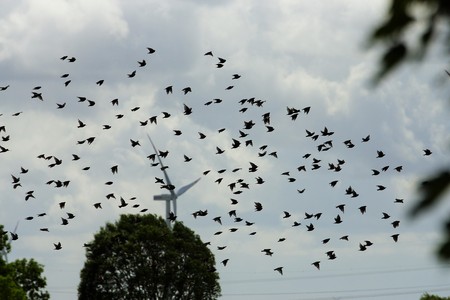Eagles, hawks, bats – these are among the most prominently cited avian wildlife regularly slaughtered by industrial-sized wind-power facilities that – thanks to taxpayer subsidies and state renewable-energy mandates — continue to spread like wildfire across rural America.
The affliction is by no means restricted to the United States, however. A new study sheds light on the carnage giant wind turbines are inflicting on wildlife in India. Researchers at the Indian Institute for Science at Bengaluru studied bird and lizard populations at three wind turbine sites in Western Ghats. They found that the mass killing of avian predators by wind turbines is having a “ripple effect” across the food chain, with lizards and small mammals adjusting to substantially reduced numbers of predators in the sky.
Wind Turbines: The New “Apex Predator”
As reported by the Daily Mail last November (and otherwise largely ignored by the media), researchers in India found almost four times fewer buzzards, hawks, and kites in areas with wind farms – a loss of about 75%. Startled by the data, scientists are now referring to wind turbines as “the new apex predator.”
In areas without wind turbines about 19 birds were spotted every three hours, while in areas with the spinning blades the number dropped to five. Fewer winged predators have been good news for the fan-throated lizard, a species found only in certain areas of the Indian Sub-Continent. The lizard is usually easy pickings for hawks, buzzards, and other birds, but with their numbers reduced by the wind turbines, the lizard’s numbers are multiplying.
“We have known from many studies that wind turbines kill birds and bats. They kill them and disrupt their movement. But we took that one step further and discovered that it affects lizards, too,” study coauthor Maria Thaker told the Daily Mail.
“Every time a top predator is removed or added, unexpected effect trickle through the ecosystem,” she added. “What is actually happening here is that wind turbines are akin to adding a top predator to the ecosystem.”
The study, which was published in Nature Ecology and Evolution, compared populations of raptors and lizards on a plateau that has had a wind farm on it for about 20 years to an adjacent valley that has no turbines.
“Humankind’s Most Pervasive Influence on the Natural World”
A recent study by an international team of scientists found the decline of apex predators is” arguably humankind’s most pervasive influence on the natural world.”
None of this is of any real concern to green groups, such as the World Wildlife Fund, who parrot the party line that the real threat to wildlife is “climate change,” not industrial-scale wind facilities and giant solar arrays they have been supporting for decades.
While India has made great strides in electrification in recent years, much still needs to be done. According to official data, “only 1,417 of India’s 18,452 villages or 7.3% of the total, have 100% household connectivity, and about 31% are still in the dark,” Forbes reported last year.
India’s future should not be dependent on interment, unreliable, unaffordable, and, as we now know, environmentally destructive wind power.
